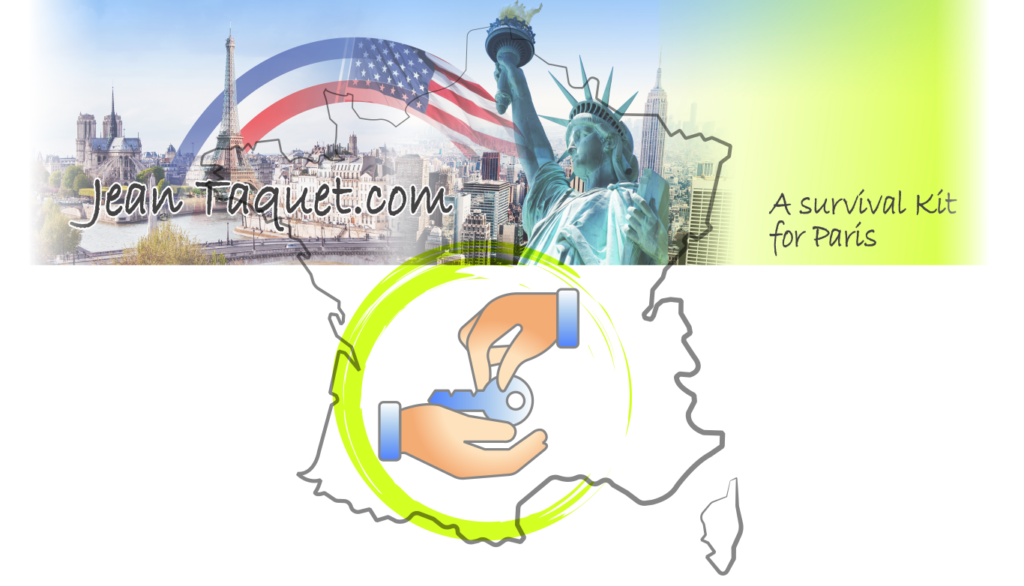Survival Home in Paris
Welcome to SHIP
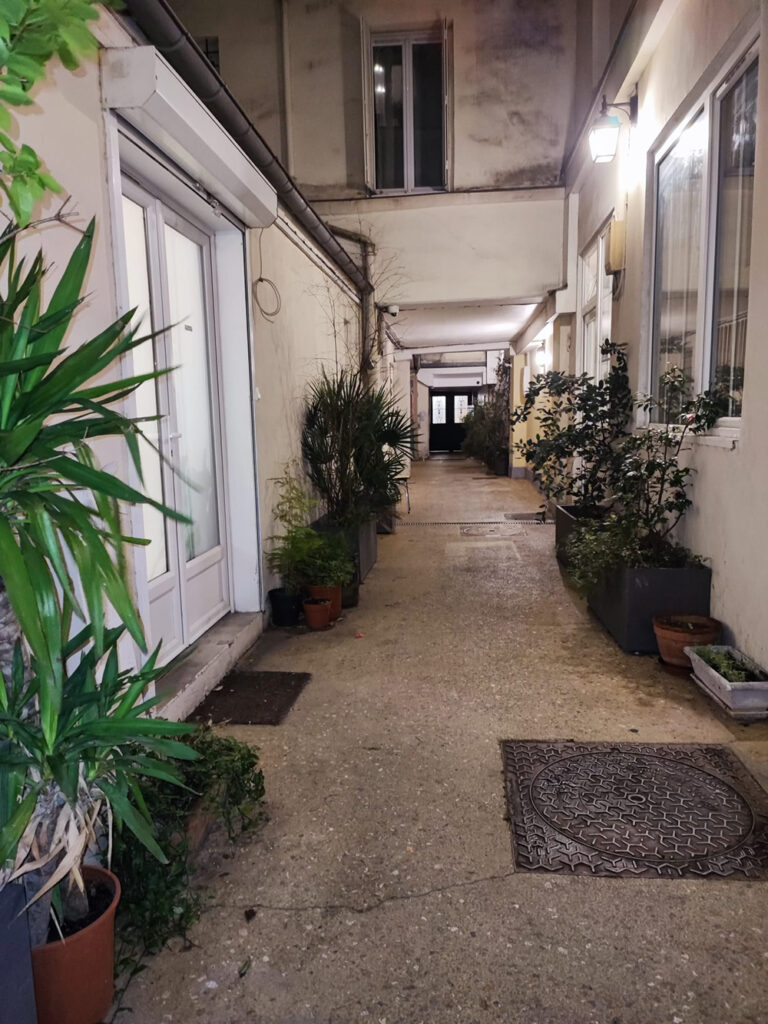
How the project began
I’m Jean Taquet. After 25 years of offering A Survival Kit for Paris, a service helping foreigners living in France as well as those aspiring to come to France, I am proud to introduce A Survival Home in Paris (SHIP).
For years now, some of my clients have used my Paris address to secure their immigration procedure, but this did not address the issue of where to stay when they first arrived in Paris.
That is why I had the idea of offering temporary rental accommodation for people who need a pleasant place to stay once they leave the airport. Guests can be on their way to France knowing they will have a place to live. While in the taxi from the airport, some of them may dream about finding a safe and cozy home knowing that SHIP is the right dock from which to cast off for a new life in France. Clients can also use SHIP to find out if moving to France is the right thing for them, or just enjoy a long visit. I see this project as extending my main professional activity of assisting foreigners in France.
SHIP is a Parisian studio of 273 square feet (25 square meters), ideal for a single person but also comfortable short-term for a couple. It can be rented for stays between 2 and 6 months. It is fully equipped, including a kitchen and separate bathroom with WC (see photos below). The first tenant moved in on January 3rd, 2023, just after the renovations were finished. No smoking or pets are allowed. The studio is next door to my office in the 11th arrondissement at 61 rue de Montreuil, on the ground floor in the courtyard. Nearby is the large circular traffic intersection called Place de la Nation. Detailed directions are provided below on how to get to SHIP from the public transport stop at Nation, with access to 6 subway lines (RER A and metro lines 1,2, 6, 8 and 9) and many bus lines.
Coming aboard SHIP
When you sign the lease, you pay the first month’s rent of 1,400€ in advance, along with a security deposit of 2,400€. After that, the monthly rent payment of 1,400€ is due no later than the first day of the month. Fees for late rent payment and other penalties will be described in your lease agreement.
You get a key to the SHIP studio, one for the mailbox, and, if you need it, one for the bicycle storage space. I will meet you at the studio and together we will complete a move-in checklist before I give you the keys.
If the keys are not returned, there is a fee of 80€. If you lock yourself out and someone needs to go to the studio to let you in, the fee is 120€.
For routine maintenance requests, such as a leaky faucet or a door that doesn’t work, you can contact me at +33 (0)6 16 81 48 07 during normal business hours Monday through Friday.
Containers for regular garbage and material to be recycled are located in the courtyard near the main entrance. Instructions on how to use them are posted next to them.
As the lease specifies, all utilities are included. Detailed information for each utility provider can be found below.
• Electricity [EDF included]
• Water [part of the condominium charges, included]
• Fiber optic internet [Free.fr included]
The lease also specifies that renter insurance is included. The policy covers you and your personal belongings in case of theft or damage, along with any personal liability claims made against you. I remind you that tenant insurance in France is cheap and comes with personal liability insurance. This alone could be a reason to subscribe for one while staying in this studio.
How to make your reservation
I manage the rental of SHIP, since this project was tailored to my clientele. To ask about a reservation, please email me at qa@jeantaquet.com. Be sure to include how long you plan to stay, the purpose of your stay, and whether you will need my consulting services. Reservations are usually made 2 to 4 months in advance, so you should contact me as early as possible to have a chance of the studio being available on your dates. Once I accept you as a tenant, I will send you a draft of the lease in English. As soon as I have received the signed lease, the security deposit and first month’s rent are paid. After I receive the money, I send you the signed lease as a PDF.
– Entry and exit walk-throughs: 150€ each. The walk throughs are available in French, English or Arabic.
– The entry walk-through includes a one-hour session with my assistant, Sarah. The session provides guidance to improve your stay, including a tour of the studio, a review of the appliances, and a look around the immediate neighborhood for things such as the nearest supermarket’s location.
What is included in the studio
(see photos below):
Bathroom
• Hot water
• Shampoo & Soap
• Hair Dryer
• Cleaning products
Bed/living room
• Sheets, pillows, blankets
(if you have fabric allergies,
please let us know and we will accommodate
your needs as much as possible)
• Drying rack
• Clothing storage space with hangers
• Towels
• Iron (on request)
• 2 tables
• Smoke detector
• A built-in safe available to the tenant
• Television
• Books (including the Routard Paris
guide in French and a guidebook in English)
• 2 radiators
• Table fan (on request)
Kitchen
• Refrigerator/freezer
• Cookware
• Dishes and cutlery
• Electric stovetop
• Microwave
• Espresso machine
• Electric kettle
• Washer/dryer
Security
• The hallway of the building has Security cameras
Not included
• Bed or crib for a baby
Your contacts
MANAGER
Survival Kit for Paris - Jean Taquet
61 rue de Montreuil 75011 Paris
[qa@jeantaquet.com]
+33 6 16 81 48 07
+33 1 40 38 16 11
ASSISTANCE
Sarah.B.
61 rue de Montreuil 75011 Paris
[sarah.b.assistance@gmail.com]
+33 7 68 49 48 53
About the neighborhood
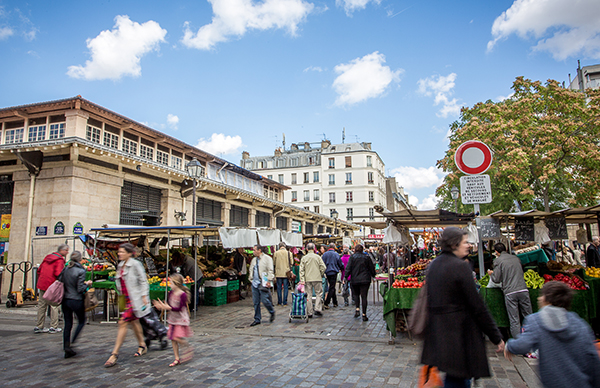
Aligre market area
Rue d’Aligre has food boutiques that are open all day and food market stalls that close at 1pm. Most of the shops specialize in fruit, vegetables, and flowers.
The covered Beauvau market, which dates from 1779, has traditional stalls selling meat, charcuterie (cured and dressed pork and other meat), cheese, and fish.
The semi-circular Place d’Aligre features a flea market and sellers of unusual objects (such as accessories and secondhand clothing).
For more on the history of the Aligre neighborhood, see below.
Shops
Boulangerie et Patisserie Artisanale, 6, rue de Montreuil
L’Autre Boulangerie, 43 rue de Montreuil
Charcot, 121 rue de Montreuil
Pépite Boulangerie, 195 Boulevard Voltaire
Laiterie Gilbert, 72 rue de Montreuil
Boucherie Moderne, 249 blvd Voltaire
Boucherie Franck et Julien (kosher), 234 blvd Voltaire
Franprix, 63-69 rue de Montreuil (next door)
Auchan A2pas, 281 rue du Faubourg Saint-Antoine
Picard (frozen food) 3 nearby shops, 15 rue des Immeubles Industriels; 86 blvd Voltaire; 8 avenue Ledru Rollin
G20, 7 rue des Immeubles Industriels
Super-U, 109 rue de Montreuil
Naturalia (health food), 119 rue de Montreuil
Carrefour, 89-191 blvd Voltaire, 142 avenue Ledru Rollin
Medical
Hospital Saint-Antoine, 184, rue du Faubourg Saint- Antoine 75012 Paris
Emergency room open 24/7, tel +33 1 49 28 20 00
SOS Médecins (house calls), tel +33 1 47 07 77 77 or dial 3624 (0.15€/min)
doctolib.fr, Medical, dental appointments
Grande Pharmacie Daumesnil, 6 place Félix Eboué, 75012 – tel +33 1 48 74 65 18 – Open Sun-Fri until 9pm, Sat to 8pm
Pharmacie Européenne, 6 place de Clichy, 75009 Paris – tel +33 1 48 74 65 18 – Open 24/7
Pharmacie des Champs-Elysées, 84 avenue des Champs-Elysées, 75008 Paris – tel +33 1 45 62 02 41 – Open every day until 8pm (except holidays)
Pharmacies near SHIP
Pharmacie Voltaire Nation, 264 blvd Voltaire, Mon-Sat until 8pm
Pharmacie Voltaire Dumas, 199 blvd Voltaire, Mon-Fri until 8pm, Sat until 7:30pm
Pharmacie Voltaire Charonne, 180 blvd Voltaire, Mon-Sat until 8pm
Most pharmacies open at 8:30 or 9am.
How to get around
Pizzeria across the street: Pizza Venise, 58 rue de Montreuil
Wine shop: Caves Bernard, 64 rue de Montreuil
MK2 Nation, 133 blvd Diderot
MK2 Bastille, 5 rue du Faubourg St Antoine
Auguste Théâtre, 6 impasse Lamier
Théâtre Le Bourvil, 13 Rue des Boulets
Comédie Nation, 77 rue de Montreuil
ENTERPRISE
enterprise.fr
Free-now : Europe’s “most popular”
free-now.com
G7 company
G7 reservation
NAVIGO PASS
iledefrance-mobilites.fr
Emergency information
DIAL 18
Fire – Gas Leak – Risk of collapse / cave-in Enshrouding – Burn – Electrocution Road / Traffic accident
Incendie – Fuite de Gaz Risque d’effondrement – Ensevelissement Brûlure – Électrocution – Accident de la route
DIAL 15
Medical emergency – Faintness, queasiness – Coma – Hemorrhaging – Chest pain – Breathing difficulties – Burnt Victim – Intoxication
Besoin médical urgent – Malaise Coma – Hémorragie -Douleur thoracique – Difficultés respiratoires Brûlé – Intoxication
DIAL 112
Danger – Violences – Assaults Mugging/Theft – Burglary
Danger – Violences – Agressions Vol à l’arraché – Cambriolage
400 years of history in this neighborhood
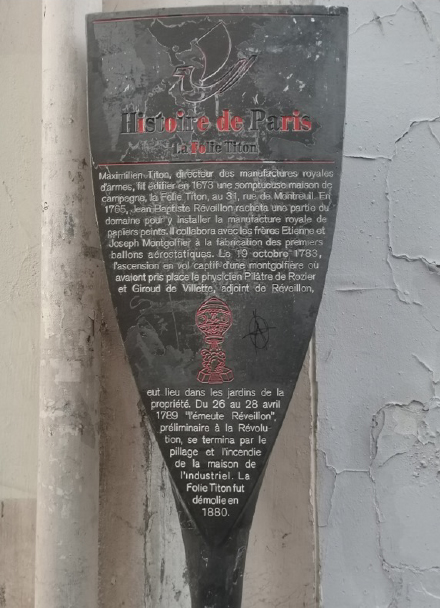
The early years
When this area was still a suburb (faubourg) of Paris, it was the site of the Battle of the Faubourg Saint-Antoine on July 2, 1652, during the anti-monarchy uprising called the Fronde.
In the 17th century, according to the geographer Jean-Aymar Piganiol de La Force, “The Faubourg Saint-Antoine increased prodigiously from the large number of houses that were built there, both because of the good air and because of the king’s letters patent of 1657, which exempted from the qualification of mastership all artisans and tradespeople who lived there.” Firewood and construction timber from higher up the Seine were unloaded at the nearby Quai de la Rapée on what was then the Ile Louviers (now attached to the Right Bank) and stored in the faubourg, leading to the development of woodworking crafts.
Skilled Flemish and German artisans, often Protestants, moved to the faubourg and worked as carvers, gilders, polishers, turners, and cabinetmakers. Jean-Baptiste Colbert, first minister to Louis XIV, established a royal mirror factory on rue de Reuilly. The wallpaper factory of Jean-Baptiste Réveillon on rue de Montreuil, which occupied part of the site of a large country estate called the Folie Titon, became a royal establishment under Louis XVI. In April 1789 the contractor running the Réveillon factory sparked a riot by threatening to cut wages. The factory was badly damaged, troops were brought in, and several dozen people were killed.
French Revolution
During the French Revolution(1789–99) the suburb was named Faubourg-de-Gloire. It gained a reputation for unrest during the revolution, starting with the storming of the Bastille on July 14, 1789. The people of the Quinze-Vingts and Montreuil neighborhoods took part in the insurrection of August 10, 1792. They also participated in the rising of June 2, 1793, which culminated in the fall of the Girondin party. The revolt of 1st Prairial Year III began in the faubourg and was savagely repressed.
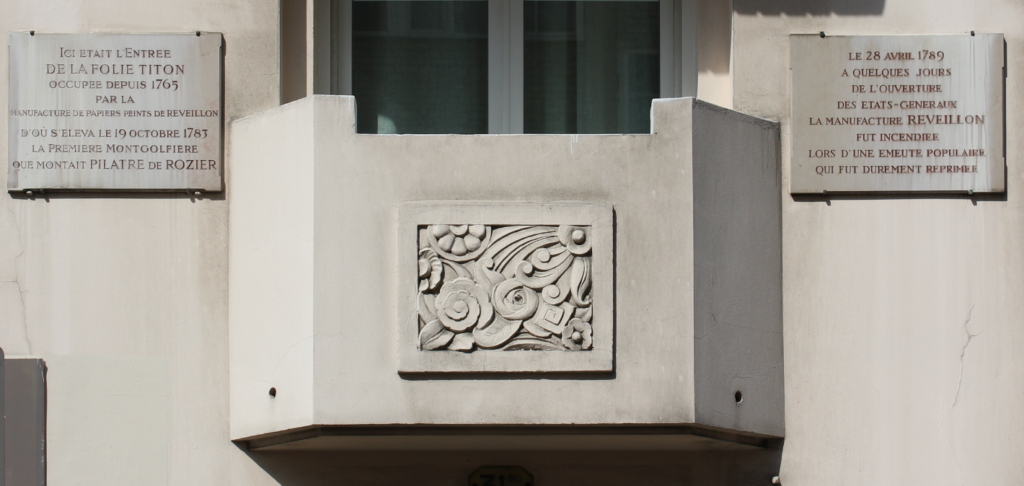
19th century
In 1808 there were 750 people, mostly children, working in the rue de Charonne spinning mills of François Richard-Lenoir (1765–1839) and Joseph Lenoir-Dufresne (1768–1806). Housed in a former convent, the machines were horse powered. In the uprising of June 1848, the Faubourg Saint-Antoine was the last district to capitulate, after being heavily shelled by artillery from the Bastille area and then attacked by troops from the Popincourt quarter, with many casualties, on the morning of June 26, 1848.
The Faubourg Saint-Antoine, policed by the Reuilly army barracks, was densely populated with people of the working and “dangerous” classes. Baron Georges-Eugène Haussmann, charged by Emperor Napoléon III with modernizing Paris, wanted to ensure that an insurrection could easily be suppressed. He proposed to the emperor that the Canal Saint-Martin’s level be lowered and the waterway covered so it could be crossed by the Boulevard de la Reine-Hortense (now the Boulevard Richard-Lenoir). He said, “I have rarely seen my august sovereign enthusiastic. This time he was so without reserve, so great an importance did he place … on the work by means of which I proposed to remove the permanent obstacle … to the line of control from which one could, in case of need, take the Faubourg Saint-Antoine from the rear.”
Haussmann split the faubourg between the 11th and 12th arrondissements and replaced the street names with numbers, but the inhabitants continued to use the old names. The former faubourg retained its revolutionary character even after it had been formally dissolved. The historian Daniel Halévy, who in his youth was a supporter of the unjustly accused Alfred Dreyfus, later wrote: “As long as the Dreyfus crisis lasted, the Faubourg Saint-Antoine was our fortress … in the little room on Rue Paul-Bert, where we huddled together, workers and bourgeois, where we squeezed our chairs one against the other. … One day in autumn 1899, we watched for hours the return of the crown of workers who had been parading on the Place du Trône, before the Triomphe de la République, Dalou’s bronze statue that had been unveiled that day. I doubt that 1848, with its famous festivals, or 1790, on the day of the Federations, saw a greater movement of the masses, or one so powerfully possessed by the spirit of the Revolution.”
Today
The Aligre district includes two markets: the covered market, whose name is Marché Beauvau or Marché Beauvau-Saint-Antoine, in the western half of the Place d’Aligre, and the open market, along the rue d’Aligre and on the eastern half of the square.
The area is named for Étienne François d’Aligre (1727-98), who was president of the Parliament of Paris at the time the market was built. The covered part of the market is named for Gabrielle-Charlotte de Beauvau, last abbess of Saint-Antoine-des-Champs and daughter of Marc de Beauvau-Craon, a member of an ancient noble family from Lorrain.
The Aligre market, one of the oldest in Paris, was where the last local market gardeners came to bring their fruit and vegetables from suburban communes such as Montreuil.
www.lemonde.fr/m-styles/article/2014/05/24/le-marche-d-aligre-un-village-a-paris_4424631_4497319.html
The first manned balloon flight
Joseph Montgolfier (1740–1810) had a passion for the innovative machines fashionable at the time of the Industrial Revolution. He and his younger brother, Etienne, often dreamed of human flight. They imagined capturing clouds in a kind of envelope and hanging a basket from it.
Their first progress came when Joseph, seeking to dry his shirt, held it by the collar over the fire in his fireplace and observed that it inflated as a result. He immediately realized the importance of this discovery. On December 14, 1782, a 3-cubic-meter globe, inflated with heated air by burning wet straw mixed with wool and paper, rose above the Montgolfier family’s paper factory at Vidalon-lès-Annonay in the Ardèche department. On April 25, 1783, an 800-m3 globe rose to an altitude of 400 meters.
The brothers had been working secretly in their garden, but as the altitude of the flights increased, they feared that their neighbors would discover their experiments and someone might steal their idea, so they organized a public take-off of their next balloon in Annonay’s main square on June 4, 1783. After that, the Académie des Sciences invited them to Paris for a demonstration. Etienne went in August 1783 and met several physicists interested in the invention. One who showed particular interest was Jean-François Pilâtre de Rozier, a chemistry professor, who would be the first man to fly in what was not yet called a hot-air balloon.
On October 15, 1783, in the gardens of the Réveillon wallpaper factor in rue de Montreuil, Pilâtre de Rozier inflated the “montgolfière,” climbed up to the circular gallery beneath the balloon and raised the globe to the end of its tether, which was some 25 meters long. On the 19th, the experiment was repeated and a crowd of the most glittering Parisian society members invaded the gardens. This time, the balloon rose to a height of 108 meters.
www.pilatre-de-rozier.com/lmab/en/2022/11/21/november-21st-1783-a-flight-to-change-history
(The history sections are freely adapted from the following sources: Wikipedia, .)
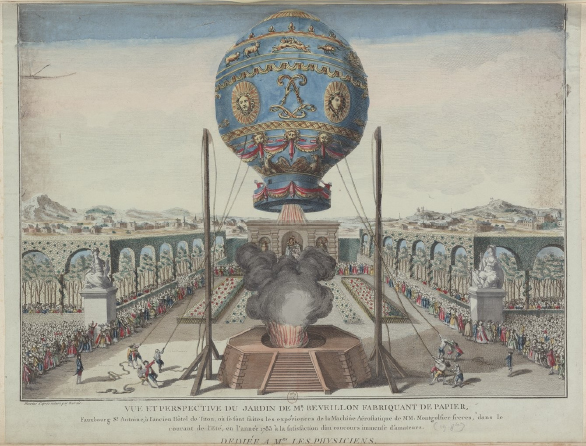
How to follow the SHIP saga as it happened
For background on our “Survival Home in Paris,” please check out my newsletter:
–“Burn” May 2019
–“The Outlaw” October 2019
–“The Call of the Wild” April 2022
–“The Best Is Yet to Come” May 2022
–“Bridge over Troubled Water” June 2022
–“Nothing Else Matters” July-August 2022
–“Summertimes Blues” September 2022
–“Wheels Are Turnin’” October 2022
–“Where Are We Going?” November 2022
–“Wind of Change” December 2022
–“Don’t Let It Bring You Down” February 2023
